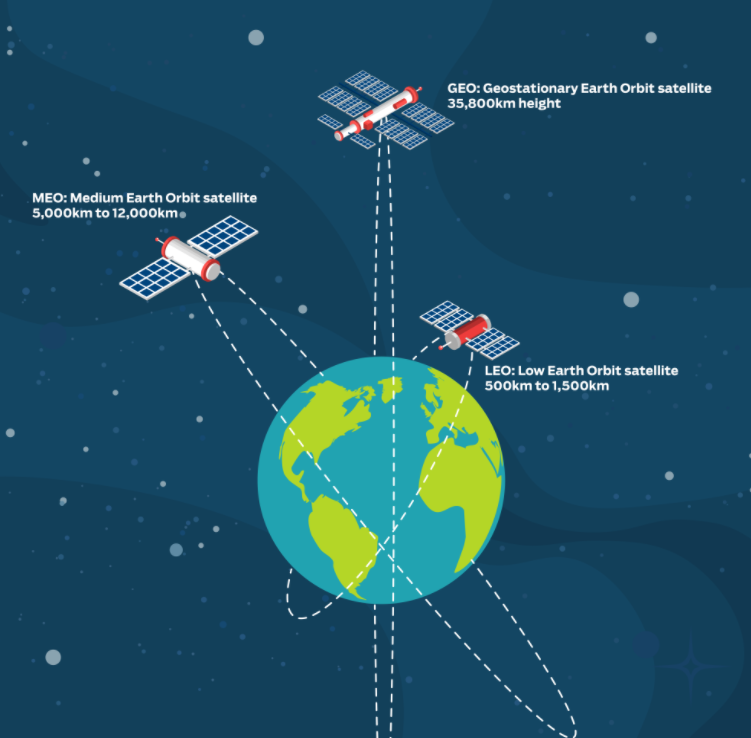Utility: Direct question can be asked on this topic. Prelims question can be asked.
Low Earth Orbit (LEO):
-
Positioning of Satellites: LEO satellites are positioned around 500km-2000km from earth, compared to stationary orbit satellites which are approximately 36,000km away.
-
Latency: As LEO satellites orbit closer to the earth, they are able to provide stronger signals and faster speeds than traditional fixed-satellite systems.
-
Additionally, because signals travel faster through space than through fibre-optic cables, they also have the potential to rival if not exceed existing ground-based networks.
-
Higher Investment: LEO satellites travel at a speed of 27,000 kph and complete a full circuit of the planet in 90-120 minutes.
-
As a result, individual satellites can only make direct contact with a land transmitter for a short period of time thus requiring massive LEO satellite fleets and consequently, a significant capital investment.
-
Due to these costs, of the three mediums of Internet – fibre, spectrum and satellite – the latter is the most expensive.

Geostationary Satellite Internet:
-
Positioning of Satellites: Geostationary orbit is located at a height of 35,786 km over the Earth’s surface, directly above the Equator.
-
Most of the existing space-based Internet systems use satellites in geostationary orbit.
-
Satellites in this orbit move at speeds of about 11,000 km per hour, and complete one revolution of the Earth at the same time that the earth rotates once on its axis.
-
To the observer on the ground, therefore, a satellite in a geostationary orbit appears stationary.
-
Coverage: The signals from one geostationary satellite can cover roughly a third of the planet and three to four satellites would be enough to cover the entire Earth.
-
Easier Connectivity: As satellites appear to be stationary, it is easier to link to them.
-
Latency Issues: The transmission from a satellite in geostationary orbit has a latency of about 600 milliseconds. The geostationary satellites are located at higher altitudes compared to LEO, thus the longer the distance that needs to be covered results in greater latency.
Existing Satellite Internet Projects:
-
‘Five to 50’ service (OneWeb):
-
OneWeb, a private company, has successfully launched constellations of 218 satellites in LEO.
-
The company only has one more launch to complete before it obtains the capacity to enable its ‘Five to 50’ service of offering internet connectivity to all regions north of 50 degrees latitude.
-
The Five to 50 service is expected to be switched on by June 2021 with global services powered by 648 satellites available in 2022.
-
-
Starlink:
-
It is a venture of SpaceX.
-
Starlink currently has 1,385 satellites in orbit and has already started beta testing in North America and initiating pre-orders in countries like India.
-
However, Starlink’s satellites fly closer to the earth and therefore, the company requires a larger fleet to provide global connectivity than OneWeb.
-
-
Project Kuiper: It is a project of Amazon announced in 2019.
-
Loon Project:
-
Google launched its ‘Loon’ project in 2013, using high-altitude balloons to create an aerial wireless network.
-
After testing the service in rural Kenya, Google’s parent company, Alphabet, abandoned the project in 2021.
-
Issues in LEO Satellites Launch:
-
Regulation Issues:
-
During the days of the Sputnik and Apollo missions, governments dominated and regulated space-based activities.
-
However, today, the balance of power has shifted from countries to companies.
-
As a result, there are questions related to who regulates these companies, especially given the large number of nations that contribute to individual projects.
-
It makes the regulatory framework complicated.
-
-
Logistic Challenge: There are logistical challenges with launching thousands of satellites into space as well.
-
Difficulty in Space Observation: Satellites can sometimes be seen in the night skies which creates difficulties for astronomers as the satellites reflect sunlight to earth, leaving streaks across images.
-
Interruptions: Satellites travelling at a lower orbit can also interrupt the frequency of those orbiting above them.
-
Space Junk: There are already almost 1 million objects larger than 1cm in diameter in orbit, a byproduct of decades of space activities.
-
Those objects, colloquially referred to as ‘space junk,’ have the potential to damage spacecraft or collide with other satellites.